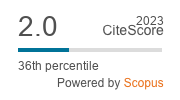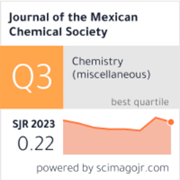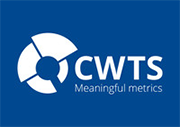Fabrication of a Highly Sensitive Nanoaptasensor for Rapid and Direct Detection of Escherichia Coli (Nasec) in Drinking Water
DOI:
https://doi.org/10.29356/jmcs.v69i2.2146Keywords:
E. coli, aptamer, aptasensor, drinking waterAbstract
Abstract. In this work, a novel nanoaptasensor (NASEc) for rapid and direct detection of Escherichia coli (E. coli) in drinking water was designed and constructed. The sensor is based on electrical conductivity measurements between a set of bare gold electrodes and a set of modified gold electrodes. The modified electrode set was covered with an aptamer layer (AE10) to improve affinity for E. coli and better binding to the electrode surface. Using the modified nanostructured layer with multiwall carbon nanotubes (MWCNT), the high sensitivity of the sensor was achieved and allowed to detect the presence of E. coli in quantities of a single colony forming units (CFU) per 100 mL. This sensitivity meets the relevant international drinking water quality standards. Each step in the process of the NASEc fabrication was verified and proved by different analytical techniques at a nanometric and molecular level: UV-vis and Raman Spectroscopy, AFM, and SEM. This portable, simple, and reusable nanoaptasensor with high selectivity and affinity offers faster detection (3 min) in the presence of E. coli compared to conventional colony forming units (CFU) counting-based methods (24 to 48 h). NASEc is designed for direct measurements without any pretreatment of samples and is helpful in potable water within a conductivity range of 50 to 1300 µS/cm.
Resumen. En este trabajo, se diseñó y construyó un nuevo nanoaptasensor (NASEc) para la detección rápida y directa de Escherichia coli (E. coli) en agua potable. El sensor se basa en mediciones de conductividad eléctrica entre un conjunto de electrodos de oro sin modificar y un conjunto de electrodos de oro modificado. El conjunto de electrodos modificado se cubrió con una capa de aptámero (AE10) para mejorar la afinidad por E. coli y una mejor unión a la superficie del electrodo. Utilizando la capa nanoestructurada modificada con nanotubos de carbono de paredes múltiples (MNTC) se logró la alta sensibilidad del sensor y permitió detectar la presencia de E. coli en cantidades de una sola unidad formadora de colonias (UFC) por 100 ml. Esta sensibilidad cumple con los estándares internacionales pertinentes de calidad del agua potable. Cada paso en el proceso de fabricación de NASEc fue verificado y probado mediante diferentes técnicas analíticas a nivel nanométrico y molecular: espectroscopia UV-vis y Raman, AFM y SEM. Este nanoaptasensor portátil, simple y reutilizable con alta selectividad y afinidad ofrece una detección más rápida (3 min) en presencia de E. coli en comparación con los métodos convencionales basados en el recuento de unidades formadoras de colonias (UFC) (24 a 48 h). NASEc está diseñado para mediciones directas sin ningún tratamiento previo de muestras y es útil en agua potable dentro de un rango de conductividad de 50 a 1300 µS/cm.
Downloads
References
Zhao, Y. W.; Wang, H. X.; Jia, G. C.; Li, Z. Sensors. 2018, 18, 1–16. DOI: https://doi.org/10.3390/s18010318.
Rompré, A.; Servais, P.; Baudart, J.; De-Roubin, M. R.; Laurent, P. J. Microbiol. Methods. 2002, 49, 31–54. DOI: https://doi.org/10.1016/S0167-7012(01)00351-7.
Khan, F. M.; Gupta, R.; Sekhri, S. Environ. Sci. Pollut. Res. 2021, 28, 60778-60786. DOI: https://doi.org/10.1007/s11356-021-14983-3.
Wu, W.; Li, M.; Wang, Y.; Ouyang, H.; Wang, L.; Li, C.; Cao, Y.; Meng, Q.; Lu, J. Nanoscale Res. Lett. 2012, 7, 658. DOI: https://doi.org/10.1186/1556-276x-7-658.
Eaton, A. D.; Clesceri, L. S.; Rice, E. W.; Greenberg, A. E.; Franson, M. A. H., in: Standard Methods for the Examination of Water and Wastewater, 21st ed., American Public Health Association, Washington, DC, 2005.
Walker, D. I.; McQuillan, J.; Taiwo, M.; Parks, R.; Stenton, C. A.; Morgan, H.; Mowlem, M. C.; Lees, D. N. Water Res. 2017, 126, 101–110. DOI: https://doi.org/10.1016/j.watres.2017.08.032.
Kuo, J. T.; Cheng, C. Y.; Huang, H. H.; Tsao, C. F.; Chung, Y. C. J. Ind. Microbiol. Biotechnol. 2010, 37, 237–244. DOI: https://doi.org/10.1007/s10295-009-0666-0.
Serra, B.; Morales, M. D.; Zhang, J.; Reviejo, A. J.; Hall, E. H.; Pingarron, J. M. Anal. Chem. 2005, 77, 8115–8121. DOI: https://doi.org/10.1021/ac051327r.
Ionescu, R. E. Escherichia coli: Recent Adv. Physiol., Pathog. Biotechnol. Appl. 2017. DOI: https://doi.org/10.5772/67392.
Hesari, N.; Alum, A.; Elzein, M.; Abbaszadegan, M. Enzyme Microb. Technol. 2016, 83, 22–28. DOI: https://doi.org/10.1016/j.enzmictec.2015.11.007.
Jiang, Y. S.; Riedel, T. E.; Popoola, J. A.; Morrow, B. R.; Cai, S.; Ellington, A. D.; Bhadra, S. Water Res. 2018, 131, 186–195. DOI: https://doi.org/10.1016/j.watres.2017.12.023.
Mallya, A. N.; Sowmya, P.; Ramamurthy, P. C., in: Organic Nanocomposite Sensor for Detection of Escherichia coli, 2014 IEEE 2nd International Conference on Emerging Electronics (ICEE), Bengaluru, India, 2014.
Khang, J.; Kim, D.; Chung, K. W.; Lee, J. H. Talanta. 2016, 147, 177–183.
Van Poucke, S. O.; Nelis, H. Appl. Environ. Microbiol. 1995, 61, 4505–4509. DOI: https://doi.org/10.1128/aem.61.12.4505-4509.1995.
Loaiza, Ó. A.; Campuzano, S.; Pedrero, M.; García, P.; Pingarrón, J. M. Analyst. 2009, 134, 34–37. DOI: https://doi.org/10.1039/b815307h.
Wutor, V. C.; Togo, C. A.; Limson, J. L.; Pletschke, B. I. Enzyme Microb. Technol. 2007, 40, 1512–1517.
Su, L.; Zhang, P.; Zheng, D.; Wang, Y.; Zhong, R. Optoelectron. Lett. 2015, 11, 157–160.
Gunda, N. S. K.; Dasgupta, S.; Mitra, S. K. PLOS ONE. 2017, DOI: https://doi.org/10.1371/journal.pone.0183234.
Zuo, P.; Li, X.; Dominguez, D. C.; Ye, B. C. Lab Chip. 2013, 13, 3921–3928. DOI: https://doi.org/10.1039/c3lc50654a.
Mitra, S. Anal. Methods. 2014, 6, 6236–6246.
Frahm, E.; Obst, U. J. Microbiol. Methods. 2003, 52, 123–131. DOI: https://doi.org/10.1016/s0167-7012(02)00150-1.
McCracken, K. E.; Angus, S. V.; Reynolds, K. A.; Yoon, J. Y. Sci. Rep. 2016, 6, 1–13.
Berg, J. D.; Fiksdal, L. Appl. Environ. Microbiol. 1988, 54, 2118–2122. DOI: https://doi.org/10.1128/aem.54.8.2118-2122.1988.
Sun, H.; Choy, T. S.; Zhu, D. R.; Yam, W. C.; Fung, Y. S. Biosens. Bioelectron. 2009, 24, 1405–1410. DOI: https://doi.org/10.1016/j.bios.2008.08.008.
Kim, Y. S.; Song, M. Y.; Jurng, J.; Kim, B. C. Anal. Biochem. 2013, 436, 22–28. DOI: https://doi.org/10.1016/j.ab.2013.01.014.
Evtugyn, G.; Porfireva, A.; Ryabova, M.; Hianik, T. Electroanalysis. 2008, 20, 2310–2316. DOI: https://doi.org/10.1002/elan.200804345.
Téllez-Plancarte, A.; Haro-Poniatowski, E.; Piquart, M.; Morales-Méndez, J. G.; Lara-Cruz, C.; Jiménez-Salazar, J. E.; Damian-Matsumura, P.; Escobar-Alarcón, L.; Batina, N. Nanomaterials. 2018, 8, 549. DOI: https://doi.org/10.3390/nano8070549.
Gómez-Reyes, A. R. E.; Monroy, O. A.; Batina, N.; Jiménez, D.; Abad, A. R.; Constantino, R.; Montero, D. P.; Tapia, F. O.; Ramírez, F.; Velázquez, E.; Morales, I.; Hernández, P.; Solís, A.; Hernández, J. de J. Mex. Pat., 2021.
Zhang, S.; Wang, X.; Li, T.; Liu, L.; Wu, H. C.; Luo, M.; Li, J. Langmuir. 2015, 31, 10094–10099. DOI: https://doi.org/10.1021/acs.langmuir.5b01272.
Ozkan-Ariksoysal, D.; Kayran, Y. U.; Yilmaz, F. F.; Ciucu, A. A.; David, I. G.; David, V.; Hosgor-Limoncu, M.; Ozsoz, M. Talanta. 2017, 166, 27–35. DOI: https://doi.org/10.1016/j.talanta.2017.01.005.
Yang, M.; Peng, Z.; Ning, Y.; Chen, Y.; Zhou, Q.; Deng, L. Sensors. 2013, 13, 6865–6881. DOI: https://doi.org/10.3390/s130506865.
Ocaña, C.; Pacios, M.; del Valle, M. Sensors. 2012, 12, 3037–3048. DOI: https://doi.org/10.3390/s120303037.
Murphy, H.; Papakonstantinou, P.; Okpalugo, T. I. T. J. Vac. Sci. Technol., B: Microelectron. Nanometer Struct. --Process., Meas., Phenom. 2006, 24, 715–720.
Le, V. T.; Ngo, C. L.; Le, Q. T.; Ngo, T. T.; Nguyen, D. N.; Vu, M. T. Adv. Nat. Sci. Nanosci. Nanotechnol. 2013, 4, 4–9.
Maquelin, K.; Kirschner, C.; Choo-Smith, L.-P.; Ngo-Thi, N. A.; van Vreeswijk, T.; Stämmler, M.; Endtz, H. P.; Bruining, H. A.; Naumann, D.; Puppels, G. J. J. Clin. Microbiol. 2003, 41, 324–329. DOI: https://doi.org/10.1128/jcm.41.1.324-329.2003.
Wu, Q.; Hamilton, T.; Nelson, W. H.; Elliott, S.; Sperry, J. F.; Wu, M. Anal. Chem. 2001, 73, 3432–3440. DOI: https://doi.org/10.1021/ac001268b.
Sengupta, A.; Mujacic, M.; Davis, E. J. Anal. Bioanal. Chem. 2006, 386, 1379–1386. DOI: https://doi.org/10.1007/s00216-006-0711-z.
Zainudin, N.; Mohd Hairul, A. R.; Yusoff, M. M.; Tan, L. L.; Chong, K. F. Anal. Methods. 2014, 6, 7935–7941. DOI: https://doi.org/10.1039/C4AY01836B.
Athamneh, A. I. M.; Alajlouni, R. A.; Wallace, R. S.; Seleem, M. N.; Sengera, R. S. Antimicrob. Agents Chemother. 2014, 58, 1302–1314. DOI: https://doi.org/10.1128/aac.02098-13.
Guler, Z.; Sarac, A. S. eXPRESS Polym. Lett. 2016, 10, 96–110.
Lian, Y.; He, F.; Wang, H.; Tong, F. Biosens. Bioelectron. 2015, 65, 314–319.
Upadhyayula, V. K. K.; Deng, S.; Mitchell, M. C.; Smith, G. B. Sci. Total Environ. 2009, 408, 1–13. DOI: https://doi.org/10.1016/j.scitotenv.2009.09.027.
Radke, S. M.; Alocilja, E. C. Biosens. Bioelectron. 2005, 20, 1662–1667. DOI: https://doi.org/10.1016/j.bios.2004.07.021.
García-Aljaro, C.; Cella, L. N.; Shirale, D. J.; Park, M.; Muñoz, F. J.; Yates, M. V.; Mulchandani, A. Biosens. Bioelectron. 2010, 26, 1437–1441. DOI: https://doi.org/10.1016/j.bios.2010.07.077.
Demattê, J. A. M.; Ramirez-Lopez, L.; Marques, K. P. P.; Rodella, A. A. Geoderma. 2017, 288, 8–22.
Hayat, A.; Marty, J. L. Front. Chem. 2014. DOI: https://doi.org/10.3389/fchem.2014.00041.
Downloads
Published
Issue
Section
License
Copyright (c) 2025 Elia Velázquez, Oscar Monroy Hermosillo , Florina Ramírez Vives , Michel Picquart , Israel Morales-Reyes , Paulina Hernández Garcés , Antonio Abad Sánchez , Eugenio Gómez Reyes Gómez Reyes , Nikola Batina

This work is licensed under a Creative Commons Attribution-NonCommercial 4.0 International License.
Authors who publish with this journal agree to the following terms:
- Authors retain copyright and grant the journal right of first publication with the work simultaneously licensed under a Creative Commons Attribution License that allows others to share the work with an acknowledgement of the work's authorship and initial publication in this journal.
- Authors are able to enter into separate, additional contractual arrangements for the non-exclusive distribution of the journal's published version of the work (e.g., post it to an institutional repository or publish it in a book), with an acknowledgement of its initial publication in this journal.









